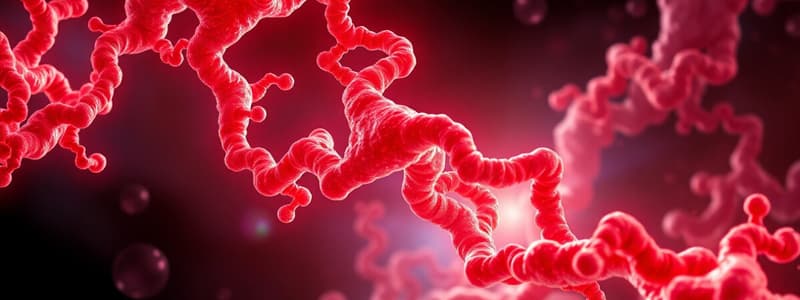Podcast
Questions and Answers
What is the role of 2,3-diphosphoglycerate (DPG) in hemoglobin function?
What is the role of 2,3-diphosphoglycerate (DPG) in hemoglobin function?
- It binds to the iron atom in the heme group, preventing oxidation to methemoglobin.
- It promotes the binding of carbon monoxide to hemoglobin, leading to carbon monoxide poisoning.
- It is a coenzyme involved in the synthesis of heme.
- It stabilizes the quaternary structure of deoxyhemoglobin, enhancing oxygen release. (correct)
What causes a right shift in the oxygen dissociation curve of hemoglobin?
What causes a right shift in the oxygen dissociation curve of hemoglobin?
- Increased affinity of hemoglobin for oxygen, resulting in increased oxygen delivery to tissues.
- Increased pH and decreased concentration of 2,3-DPG.
- Reduced affinity of hemoglobin for oxygen, resulting in enhanced oxygen delivery to tissues.
- Decreased pH and increased concentration of 2,3-DPG. (correct)
Which statement accurately describes the structure of hemoglobin?
Which statement accurately describes the structure of hemoglobin?
- It is a tetrameric protein composed of two alpha and two beta subunits. (correct)
- It is a single polypeptide chain with a single heme group.
- It is a fibrous protein with a helical structure.
- It is a globular protein that contains four heme groups, each binding to a single iron atom. (correct)
What is the effect of carbon monoxide (CO) on hemoglobin?
What is the effect of carbon monoxide (CO) on hemoglobin?
Which of the following is NOT a factor that influences the oxygen dissociation curve of hemoglobin?
Which of the following is NOT a factor that influences the oxygen dissociation curve of hemoglobin?
Which of the following statements is TRUE regarding hemoglobin synthesis?
Which of the following statements is TRUE regarding hemoglobin synthesis?
What is the main function of hemoglobin in the body?
What is the main function of hemoglobin in the body?
What is the difference between hemoglobin A (Hb A) and fetal hemoglobin (Hb F)?
What is the difference between hemoglobin A (Hb A) and fetal hemoglobin (Hb F)?
What effect does a higher pH have on the binding of oxygen to hemoglobin?
What effect does a higher pH have on the binding of oxygen to hemoglobin?
Which of the following accurately describes hematocrit?
Which of the following accurately describes hematocrit?
Which condition would likely cause a decrease in hematocrit levels?
Which condition would likely cause a decrease in hematocrit levels?
What is a common method for carrying out a hematocrit test?
What is a common method for carrying out a hematocrit test?
What are the normal hematocrit ranges for females?
What are the normal hematocrit ranges for females?
Flashcards
Hemoglobin A (Hb A)
Hemoglobin A (Hb A)
Normal adult hemoglobin, made of four polypeptide chains (α2β2) and four heme groups.
Protoporphyrin
Protoporphyrin
A molecule that combines with iron (Fe2+) to form heme, which colors it deep red.
Oxygen Binding to Hemoglobin
Oxygen Binding to Hemoglobin
Binding of O2 causes a conformational change in hemoglobin structure, allowing transport.
2,3-Diphosphoglycerate (DPG)
2,3-Diphosphoglycerate (DPG)
Signup and view all the flashcards
Hemoglobin Synthesis
Hemoglobin Synthesis
Signup and view all the flashcards
Oxygen Dissociation Curve - Right Shift
Oxygen Dissociation Curve - Right Shift
Signup and view all the flashcards
Methemoglobin
Methemoglobin
Signup and view all the flashcards
Fetal Hemoglobin (Hb F)
Fetal Hemoglobin (Hb F)
Signup and view all the flashcards
Bohr Effect
Bohr Effect
Signup and view all the flashcards
Hematocrit
Hematocrit
Signup and view all the flashcards
RBC volume fraction
RBC volume fraction
Signup and view all the flashcards
Normal hematocrit ranges
Normal hematocrit ranges
Signup and view all the flashcards
Microhematocrit tube
Microhematocrit tube
Signup and view all the flashcards
Study Notes
Hemoglobin Structure
- Normal adult hemoglobin A (Hb A) consists of four polypeptide chains (α₂β₂).
- Hb A also contains Hb F and Hb A₂.
- Hb A has four heme groups.
- The table shows the percentage of each hemoglobin type found in adult blood.
| Hemoglobin Type | Structure | Normal Percentage (%) |
|---|---|---|
| Hb A | α₂β₂ | 96-98 |
| Hb F | α₂γ₂ | 0.5-0.8 |
| Hb A₂ | α₂δ₂ | 1.5-3.2 |
Hemoglobin Formation
- Hemoglobin is formed via a series of steps.
- The first is combining 2 succinyl-CoA and 2 glycine.
- This creates 4 pyrroles.
- Protoporphyrin IX is then formed from the 4 pyrroles
- Protoporphyrin IX and ferrous iron (Fe²⁺) combine to form heme.
- Heme then combines with polypeptide chains (α or β) to create a hemoglobin chain.
- Two α chains and two β chains combine to create hemoglobin A.
Hemoglobin Structure (Detailed View)
- Hemoglobin is a globular protein.
- It has a quaternary structure formed by four polypeptide chains (globins) arranged in a tetramer (two α chains and two β chains).
- Each globin chain has a heme group.
- Heme contains an iron atom (Fe) which binds to oxygen.
Hemoglobin Function
- Carries oxygen from the lungs to the tissues.
- Returns CO₂ from the tissues to the lungs.
- Hemoglobin's oxygen-carrying capacity depends on several factors:
- The presence of 2,3-diphosphoglycerate (DPG)
- The pH level
- The partial pressure of CO₂
- Hemoglobin structure
- When iron (Fe²⁺) is oxidized to iron (Fe³⁺), methemoglobin is formed (brown in color)
- Carbon monoxide (CO) binds strongly to hemoglobin, preventing oxygen binding.
Hemoglobin Synthesis
- Hemoglobin synthesis occurs in the mitochondria.
- Vitamin B₆ acts as a coenzyme in the reaction.
- Iron is supplied by the circulation transferrin.
- Globin chains are synthesized on ribosomes.
- Protoporphyrin combines with ferrous iron (Fe²⁺) to form heme.
- Four globin chains, each with a heme group, combine to form a hemoglobin molecule.
Hematocrit
- Hematocrit measures the percentage of red blood cells (RBCs) in a blood sample after centrifugation.
- It is also referred to as packed cell volume (PCV) or erythrocyte volume fraction (EVF).
- Normal ranges are different in males, females, and newborns.
- It measures the viscosity of blood. The higher the hematocrit, the higher the viscosity.
- A lower hematocrit may indicate anemia, while a higher hematocrit may indicate polycythemia
- RBC or hemoglobin counts are less accurate than hematocrit measurements; measurement abnormalities in hematocrit show a larger error rate.
Bohr Effect
- A decrease in pH promotes the release of oxygen from hemoglobin.
- An increase in pH promotes the binding of oxygen to hemoglobin.
- The Bohr effect is due to the interaction between hydrogen ions (H⁺) and hemoglobin.
- CO2 reacts with water creating carbonic acid (H₂CO₃) which dissociates into hydrogen ions and bicarbonate ions (HCO₃⁻).
Other important notes and factors
- Carbon monoxide (CO) is toxic because it binds more strongly to hemoglobin than oxygen, preventing oxygen from binding.
- Certain drugs or toxins can oxidize the iron in hemoglobin to form methemoglobin. This alters hemoglobin function.
Studying That Suits You
Use AI to generate personalized quizzes and flashcards to suit your learning preferences.




